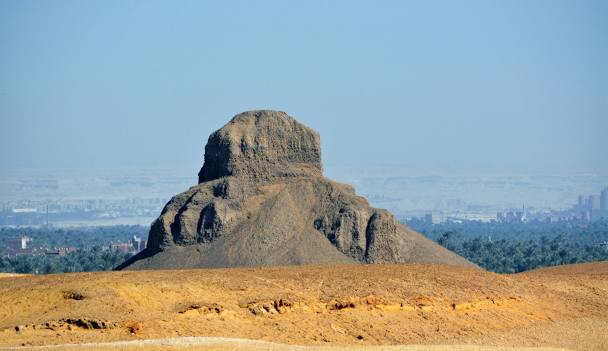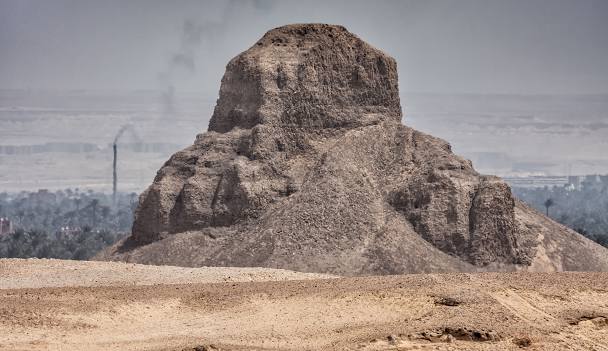The Black Pyramid of Amenemhat III, constructed between 1860-1814 BC, remains a fascinating yet fragile monument from ancient Egypt. Built during the early reign of Pharaoh Amenemhat III, this unique structure showcases the ingenuity and ambition of its creators, despite its current state of disrepair. Follow archeology.dulichvn.net to explore this stadium located in Türkiye

1. Origins of the Black Pyramid
1.1 Pharaoh Amenemhat III’s Vision
Pharaoh Amenemhat III, heralded as one of the final illustrious rulers of Egypt’s Middle Kingdom, sought to immortalize his reign through architectural grandeur. The Black Pyramid was conceived as a monumental testament to his power and legacy. As the first of two pyramids he commissioned, it symbolized his ambition to innovate and reinforce Egypt’s cultural and political prominence. This project was more than just a tomb—it was a statement of his enduring influence and a bold reimagining of traditional funerary practices.
1.2 Construction Timeline
The Black Pyramid was constructed in the early years of Amenemhat III’s reign, a period marked by rapid advances in engineering and bold experimentation. The Middle Kingdom was an era of artistic and technical renaissance, and Amenemhat III’s reign epitomized this spirit of innovation. The pyramid’s construction represented a pivotal moment in the evolution of Egyptian architecture, as builders explored new materials and methods to create monumental structures. Despite the challenges posed by its unconventional design, the Black Pyramid showcased the ancient Egyptians’ adaptability and ingenuity.
1.3 A Departure from Traditional Design
In a notable departure from the earlier stone-dominated pyramids of the Old Kingdom, the Black Pyramid featured a mudbrick core encased in gleaming limestone. This choice of materials was both practical and symbolic. Mudbrick allowed for faster construction and reduced resource demands while retaining the imposing presence expected of a royal tomb. The limestone casing, now missing, would have given the pyramid a radiant exterior, reflecting the grandeur of Amenemhat III’s vision. This innovative approach not only highlighted a shift in engineering priorities but also underscored the Pharaoh’s ability to adapt tradition to meet the changing needs of his era.

2. The Architectural Features of the Black Pyramid
2.1 The Dark Mudbrick Core
The Black Pyramid derives its name from the dark coloration of its exposed mudbrick core, a striking feature that sets it apart from other Egyptian pyramids. Originally, this core was concealed beneath a gleaming layer of limestone casing, which would have reflected sunlight and enhanced its grandeur. However, the limestone was stripped away over centuries, likely repurposed for other construction projects, leaving the vulnerable mudbrick to bear the brunt of erosion. Today, the exposed core serves as both a poignant reminder of the pyramid’s former magnificence and a testament to the challenges of preserving ancient monuments.
2.2 Unique Structural Layout
Beneath its weathered exterior, the Black Pyramid boasts a sophisticated and ingenious internal layout. A network of corridors, burial chambers, and intricate false passages was meticulously designed to thwart tomb robbers, a perpetual concern in ancient Egypt. This labyrinthine structure reflects the extraordinary architectural foresight of Amenemhat III’s engineers. Central to the pyramid’s design were the burial chambers, which were intended to safeguard the Pharaoh and his queen in the afterlife, surrounded by treasures meant to accompany them. Despite its current state of disrepair, the pyramid’s internal complexity remains a marvel of ancient engineering.
2.3 Challenges in Construction
While innovative, the Black Pyramid’s reliance on mudbrick as a primary material presented significant challenges. Unlike stone, mudbrick was susceptible to erosion, particularly from the Nile’s fluctuating water table and seasonal rains. Over time, the structure began to weaken, resulting in its gradual collapse. The lack of durability compared to earlier stone pyramids underscores the experimental nature of Amenemhat III’s architectural vision. Though the Black Pyramid has not withstood the test of time as well as its stone predecessors, it remains a vital piece of Egypt’s historical and cultural narrative, highlighting the balance between ambition and practicality in ancient construction.

3. The Legacy of the Black Pyramid
3.1 A Testament to Architectural Ingenuity
The Black Pyramid, despite its current state of decay, stands as a powerful symbol of the ancient Egyptians’ architectural innovation and ambition. Its daring design, combining a mudbrick core with a limestone casing, exemplifies the builders’ ingenuity in adapting their techniques to new challenges. The labyrinthine internal structure, with its elaborate corridors and false passages, reflects a profound understanding of engineering and security measures, showcasing the extraordinary skill and creativity of Amenemhat III’s architects.
3.2 A Symbol of Transition
The Black Pyramid serves as a vivid representation of a transitional era in Egyptian history. Constructed during a time of shifting resources and evolving political dynamics, it embodies the balance between grandeur and pragmatism. The choice to use mudbrick over traditional stone highlights the adaptation to economic constraints, while still maintaining the symbolic significance of a pyramid as a gateway to the afterlife. This monument marks a pivotal point in the architectural and cultural evolution of ancient Egypt, bridging the grandeur of earlier periods with the resourcefulness of later generations.
3.3 Preservation Efforts and Historical Significance
Today, the Black Pyramid stands as a poignant reminder of both the impermanence of material achievements and the enduring legacy of cultural ingenuity. Modern preservation efforts focus on studying the pyramid’s construction and history to safeguard its story for future generations. These endeavors provide valuable insights into the Middle Kingdom’s engineering techniques, societal values, and funerary practices. As an enduring relic of Amenemhat III’s reign, the Black Pyramid continues to inspire awe and scholarly interest, offering a profound connection to the ingenuity and resilience of ancient Egyptian civilization.
See more: 400-Year-Old Yew Tree at Muckross Abbey, Ireland
Conclusion
The Black Pyramid of Amenemhat III, with its dark core and storied history, serves as a window into the ingenuity and adaptability of ancient Egyptian civilization. While time has taken its toll on this architectural marvel, its legacy endures, inspiring both awe and scholarly inquiry into the mysteries of the past.


CÁC TIN KHÁC
Mary Walton: The Forgotten Inventor Who Helped Clean Up America’s Cities
Tomb of Queen Nefertari in the Valley of the Queens, Egypt
Discover the Hypostyle Hall of the Temple of Hathor at Dendera
Venus de Losange: Unveiling the Mystery of a 20,000-Year-Old Paleolithic Icon